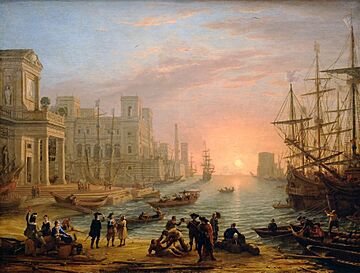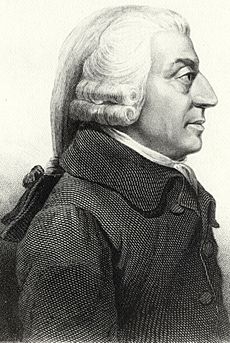Mercantilism facts for kids
Mercantilism was an economic system popular in Europe from the 1500s to the 1800s. The main goal of mercantilism was for a country to become as wealthy and powerful as possible.
To do this, a country tried to sell (export) more goods to other countries than it bought (imported) from them. This way, more money, especially gold and silver, would flow into the country. Governments made many rules to control trade, help their own businesses, and weaken their rivals.
These policies often led to competition and even wars between nations. They also encouraged countries to create colonies around the world to get resources and sell more goods. Today, some of these ideas can still be seen in modern policies called neomercantilism.
Contents
History of Mercantilism
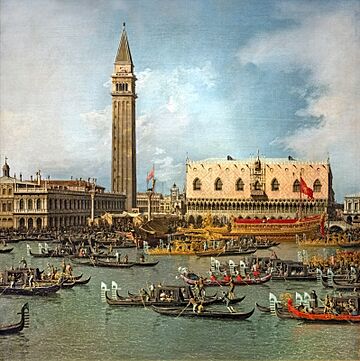
Mercantilism was the most popular economic idea in Europe from about the 15th to the 18th century. This was a time of great change, during the late Renaissance and the early modern period. Early forms of mercantilism were seen in cities like Venice and Genoa, which controlled trade in the Mediterranean Sea.
The core idea of early mercantilism was bullionism. This meant that a nation's wealth was measured by how much gold and silver it had stored up. However, thinkers soon realized that money needed to move through the economy to create more wealth, not just sit in a vault.
England's Rise
England began to use mercantilist ideas in a big way during the rule of Queen Elizabeth I (1558–1603). The government wanted to build a strong navy and merchant fleet to compete with Spain. They passed laws to protect English shipping and encourage trade.
Later, in the 1650s, England passed the first Navigation Acts. These laws were designed to control trade and make sure that most of the profits from trade with its colonies went to England.
France and Colbertism
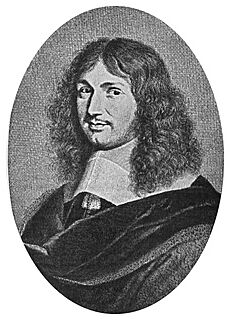
In France, mercantilism reached its peak in the 1600s under Jean-Baptiste Colbert. He was the finance minister for King Louis XIV. His policies were so influential that French mercantilism is often called Colbertism.
Colbert believed the government should control the economy to make the state powerful. He put high taxes (tariffs) on imported goods to protect French businesses. He also gave money to new industries and set up strict rules for how goods should be made to ensure high quality. His policies helped France's economy grow, making it a dominant power in Europe.
Key Ideas of Mercantilism
Mercantilist thinkers believed a country's economy should be managed carefully to increase national power. While there was no single book of rules, their ideas can be summed up in a few key points:
- Use all land for the nation: Every bit of a country's land should be used for farming, mining, or manufacturing.
- Make finished goods: Use a country's own raw materials to make products. Finished goods are worth more than raw materials.
- Encourage a large population: A large population could provide workers for factories and soldiers for the army.
- Keep gold and silver in the country: Banning the export of gold and silver was a common rule.
- Limit imports: Discourage people from buying foreign goods as much as possible.
- Trade for goods, not money: If a country had to import something, it should try to trade its own goods for it instead of paying with gold or silver.
- Sell to other countries: Always look for opportunities to sell extra goods to foreigners for gold and silver.
- Buy local: People should not be allowed to import goods that could be made at home.
Mercantilists saw the world's wealth as limited. They viewed trade as a zero-sum game, meaning that for one country to get richer, another had to become poorer.
Mercantilism in Action
European nations used many different policies to follow the ideas of mercantilism.
Policies in Europe
- High Tariffs: Governments placed high taxes on imported goods, especially manufactured ones, to make them more expensive than local products.
- Colonial Trade Rules: Colonies were often forbidden from trading with any country other than their mother country.
- Shipping Restrictions: Laws like England's Navigation Acts required that trade be carried on ships from the home country.
- Support for Exports: Governments gave money (subsidies) to businesses to help them sell their goods abroad.
- Controlling Resources: Nations tried to maximize the use of their own resources, like wood and coal.
The American Colonies
British mercantilism had a big impact on its colonies in North America. The British government and merchants worked together to increase their wealth. They passed laws that controlled colonial trade to benefit Britain.
For example, the colonies had to sell raw materials like tobacco and lumber only to England. They were also forced to buy manufactured goods from England. These restrictions on trade angered many colonists and became a major reason for the American Revolution.
Competition, Colonies, and Conflict
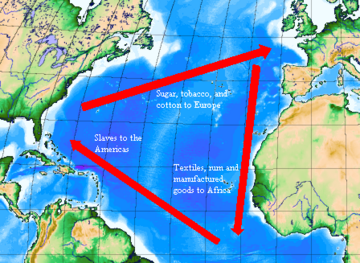
Under mercantilism, countries saw trade as a form of warfare. They believed the only way to increase their share of world trade was to take it from another country. This intense competition led to many wars, such as the Anglo-Dutch Wars and the Franco-Dutch Wars, which were fought over control of trade routes and colonies.
Mercantilism also fueled imperialism. European nations raced to build empires and conquer new colonies. These colonies were valuable because they provided:
- Raw materials like sugar, cotton, and metals.
- New markets where the mother country could sell its finished goods.
A very dark part of this system was the triangular trade. European ships would travel to Africa, where people were captured and forced onto ships. These enslaved people were taken to the Americas and forced to work on large farms called plantations. The goods they produced, like sugar and cotton, were then shipped back to Europe. This trade was incredibly cruel and caused immense suffering, but it made the European countries very wealthy.
The End of the Mercantilist Era
In the late 18th century, people began to question the ideas of mercantilism. Thinkers like David Hume and John Locke pointed out flaws in the system.
The biggest challenge came from a Scottish philosopher named Adam Smith. In 1776, he published a famous book called The Wealth of Nations. In his book, Smith argued against mercantilism. He made several key points:
- Wealth is not just gold: Smith said a country's true wealth was in its ability to produce goods and services, not just the amount of gold it had.
- Trade is a win-win: He argued that trade could be good for both countries involved. It wasn't a zero-sum game.
- The "Invisible Hand": Smith promoted the idea of free trade and laissez-faire economics, where the government interferes less in the economy.
Smith's ideas became very popular and laid the foundation for modern classical economics. Over the 19th century, countries like Britain and France abandoned mercantilism in favor of free trade.
Mercantilism's Legacy Today
Even though the age of mercantilism is over, some of its ideas still exist. When a country uses policies to protect its own industries from foreign competition, it is sometimes called protectionism.
Modern versions of these policies are often called neo-mercantilism (which means "new mercantilism"). A country following neo-mercantilist policies might:
- Keep the value of its money low to make its exports cheaper.
- Give subsidies to its own industries.
- Put high tariffs on imported goods.
For example, when Donald Trump was president of the United States, his administration placed tariffs on goods from other countries, especially China. The goal was to encourage people to buy American-made products and protect jobs in the U.S. Some experts described these policies as a form of neo-mercantilism.
See also
 In Spanish: Mercantilismo para niños
In Spanish: Mercantilismo para niños


